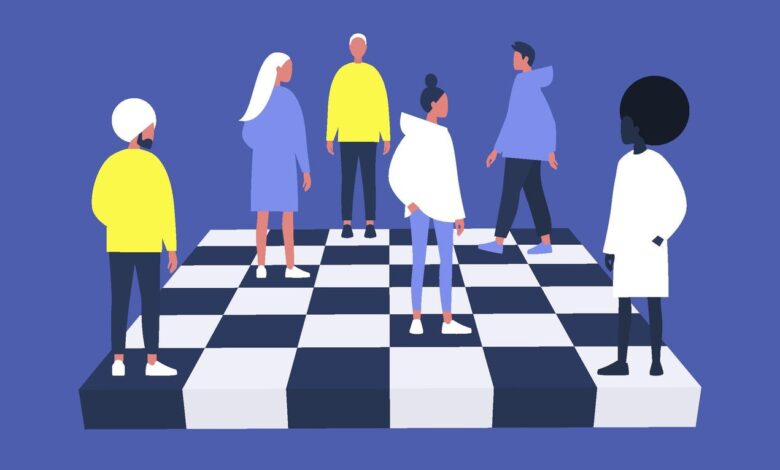From Build And Buy To Bridge, Borrow, And AI

📝 usncan Note: From Build And Buy To Bridge, Borrow, And AI
Disclaimer: This content has been prepared based on currently trending topics to increase your awareness.
A group of diverse characters playing chess on a chessboard, management concept
getty
Most organizations believe they have a leadership talent pipeline. What they actually have is an illusion of readiness. Roles are being reshaped in months, not years. Succession plans expire before they’re tested. And the leaders needed for tomorrow—tech fluent, adaptive and globally minded—are the very ones companies don’t know how to grow.
The numbers reveal the gap. The World Economic Forum reports that on average, workers can expect that two-fifths (39%) of their existing skill sets will be transformed or become outdated over the 2025–2030 period. Gallup finds fewer than a third of employees believe they have real opportunities to learn and grow and less than half received any training last year. Only one in three employees aiming for a new role feels equipped to succeed.
The cost isn’t abstract. Unfilled leadership roles slow growth, drain revenue, stifle innovation and erode confidence. Consider a division head retiring unexpectedly. The successor identified on paper isn’t ready, and six months pass before the team regains direction—while competitors move ahead.
To understand how organizations should respond, I spoke with Lynda Gratton, Professor of Management Practice at London Business School, a global advisor to Fortune 500 companies and the author of best-selling books including The 100-Year Life, Living Strategy and Redesigning Work. For more than three decades, Gratton’s research has reframed how organizations think about leadership, skills and the future of work.
She has watched the scaffolding of old systems loosen, and her conclusion is direct: the playbook must expand. “For years there were two stable strategies,” Gratton explained. “One was build—you bring people in as graduates, you move them around, they become embedded in the culture and ready for the top jobs. The other was buy—when the pipeline isn’t enough, you go to the market. Those worked pretty well.”
Gratton describes build and buy as cultural anchors—steady, predictable, tied to values. But, as she emphasizes, “while they remain the core, they are no longer sufficient on their own.”
What’s needed now is a repertoire that preserves continuity and also builds adaptability.
Build and Buy: The Anchors of Continuity
From a strategic standpoint, build and buy remain the foundation of leadership systems. They preserve culture, protect institutional memory and provide a stable core for succession. But in a world where work is shifting faster than careers can keep pace, they must be complemented by approaches that reach across boundaries.
Bridge: Unlocking Talent Across Boundaries
“One adaptive strategy is bridge,” Gratton said. “There is talent within the organization, but it’s not doing the job we need it to be doing in the future. So we bridge across jobs. Conversations about skills are what matter, so people can use their abilities to move into different sorts of roles.”
Bridging is a response to the mismatch between current capability and future demand. A compliance leader moving into sustainability governance or a facilities manager leading an IoT rollout are not one-off shifts. They’re deliberate investments in cross-boundary capacity that keep organizations competitive.
But bridging fails if development remains bolted on instead of built in. Gallup reports that time away from responsibilities is the top barrier to growth, according to 89% of CHROs, 37% of managers and 41% of employees.
The obsession with conventional career ladders continues. While nearly 70% of employees are looking for a new role within their organization, only 28% would consider a lateral one. Career growth inside companies still follows a narrow script—progress often defined by vertical movement alone.
Borrow: Bringing in Talent Without Owning It
“The other adaptive strategy is borrow—you borrow from the external labor market for a short period of time,” Gratton explained. “The article Diane Gerson and I wrote in Harvard Business Review about freelancers was important: ‘I want your job, but not your work.’”
Borrowing is a way to build agility. Contractors, consultants, gig specialists and even fractional executives give companies access to capabilities at exactly the moment they’re needed.
But there are risks. “If you outsource too much, you weaken the very culture you’re trying to sustain,” Gratton cautioned. “Even the most freelance-heavy organizations have a small center that defines identity and strategy.”
Fractional leadership shows the point. CFOs, CMOs and even CEOs are now hired on fractional terms. These roles can stabilize organizations in transition but don’t provide continuity. Without translating that know-how into durable capability inside, companies risk dependency instead of growth.
Borrowing works best when paired with bridging—capturing the practices and knowledge from external experts and embedding them into internal teams.
AI: The Fifth Force in Workforce Strategy
“AI changes the way we think about talent pipelines,” Gratton told me. “It shrinks the half-life of skills, and it lets you anticipate talent needs much faster than before.”
AI is no longer just an efficiency tool. It can act as a sensor, spotting succession risks, forecasting gaps and aligning leaders to emerging priorities.
“When you use AI in succession planning,” Gratton added, “you can see that someone is about to retire and quickly identify who could step in—with their development tailored to the job they’re moving into.”
That makes AI one strategy in its own right. It can augment talent management by providing sharper analytics, uncovering hidden skills and dynamically matching people to opportunities. But the debate runs deeper: what happens when AI begins to take on the critical tasks of talent itself?
Some outsourcing may make sense. AI can run financial forecasts, write code, draft legal documents, generate marketing copy, simulate supply chain risks or even triage customer service inquiries. It can screen applications, model workforce needs and build learning simulations faster than humans ever could. Done well, this can unburden leaders and free people to spend more time on judgment, relationships and strategy.
But there are lines AI cannot cross. Discernment, empathy, strategic choice—these are the core of leadership. No machine can substitute for an executive weighing the trade-offs of a merger, deciding whether to enter a new market or leading people through crisis. If organizations push too far in outsourcing these calls, they risk hollowing out the very capabilities they claim to be developing.
The open question is impact. Will AI strip away valuable developmental experiences by taking on tasks that once helped grow future leaders? Or will it elevate human talent by removing low-value burdens and giving leaders more space to focus on what matters most?
The jury is still out. As AI evolves, the question is not just how it supports talent strategy, but whether it will become part of the talent pool itself. For now, it remains a tool—powerful, indispensable, but not a substitute for human leadership.
Which Moves Work Best?
At this point, a fair question for any leader is: which of these strategies—build, buy, bridge, borrow or AI—will actually work in the future?
The answer is not straightforward. One could argue you need all of them, or at least systems that allow each to be deployed when the moment demands it. The deeper point is that talent strategies need to be adaptable. They should be guided by business strategy and context, not by rigid ideas about roles.
When companies typecast roles—assuming, for example, that senior executives must always be built internally or that technical specialists must always be bought externally—they limit how talent can be leveraged. A more powerful approach is to treat the five strategies as a variable system.
That means in talent reviews, the conversation should not presuppose a single strategy. Instead, each leadership need should be examined through all five possibilities. Could this role be bridged across functions? Could it be borrowed in the short term? Could it be rebuilt through AI-driven development insights? The value lies in calibrating across strategies rather than defaulting to one.
Gratton, in her work, emphasizes this danger: when talent strategies are tied too tightly to roles, organizations miss the chance to see capability in different contexts. That’s where companies get stuck.
The Disruptor’s Advantage
“The disruptors—new entrants—build from a different model,” Gratton said. “They use AI, operate with freelance groups and design for agility from the start. Change won’t come from inside incumbents—it will be driven from outside.”
Talent markets are shifting as quickly as work expectations themselves. The Great Resignation has given way to what Gallup calls the Great Detachment—fewer people moving but more disconnecting from the meaning of corporate careers. Gratton’s research confirms the trend: new talent ecosystems are emerging, built for speed and flexibility.
In that environment, Gratton believes the edge belongs to future-fluent leaders—those who combine technological fluency with distinctly human strengths like discernment, critical thinking and the ability to catalyze change.
Companies that cling to outdated tools—nine-box grids, tenure as a proxy for readiness, succession indicators that miss real potential—risk being overtaken entirely. Disruptors hold the advantage because they aren’t tied to legacy systems. Incumbents need to unlearn quickly if they want to withstand the shocks ahead.
Keeping the Cultural Core Intact
Moves may multiply, but culture depends on anchor leaders. “You couldn’t anticipate a culture where every single person’s a freelancer,” Gratton warned. “Because… what is this place, and how does it work?”
A clear framework emerged from our conversation:
- A stable core through build and buy, preserving values and strategy
- A flexible outer layer of bridge and borrow, refreshed continuously
- AI as a sensor, connecting and optimizing the whole
The danger is not years away—it’s here. Pipelines are thinning now. Successors are unready when the call comes. Promising leaders are leaving before their potential is realized. Organizations that keep postponing decisions will see their cultures wear down under the strain.
As Gratton put it: “If you’re not shaping the future, you’re being shaped by it.”
Shaping the future of talent isn’t abstract. It happens in every vacancy left open, every leader not developed, every skill gap ignored until it fractures the system. Readiness is only real when leaders build it as they go.




